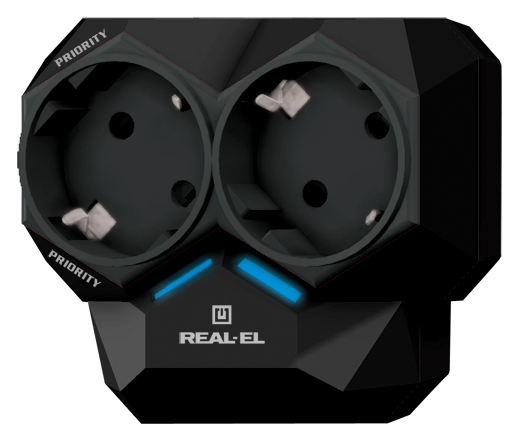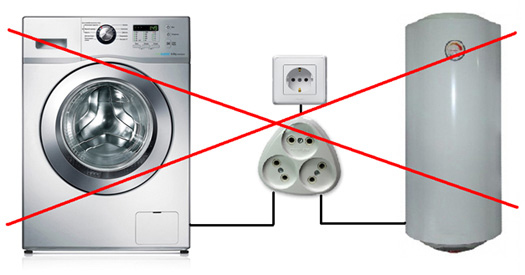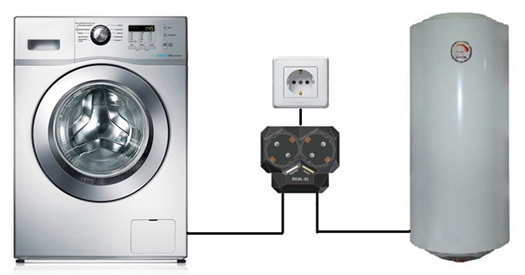14.09.2015
When stuffing your apartment with new modern electrical devices, it should be thought without fail, if there enough the dedicated power of the power supply network in an apartment to provide the required power supply to electrical appliances.
It is difficult to imagine a modern apartment not equipped with an air-conditioner, washing machine, kitchen extractor fan, dishwasher, warm floor or, if worst comes to worst, with a simple iron, microwave stove, water heater or electric kettle. With such abundance of powerful household appliances in every apartment, it is hardly surprising that most people face problems of disconnection of automatic input circuit breakers (fuses).
But the installation of more powerful automatic breakers leads to the wire heating in an apartment. The heightened wire heating will result in the insulation breakdown, that at its best can cause just the smoke generation in an apartment, but at the worst – a fire. Moreover, even the complete wire and automatic breaker replacement in the apartment, – will not solve the problem, because the wiring in an entrance hall and in the whole house is not designed for such big loads.
In addition, there is a risk to damage the neutral wire in the common house electric service cabinet and to create in this case a lot of problems for all dwellers of the apartment house. In this case, the Public Housing and Utilities Office will bear no responsibility at all, and according to legal precedents, a fire initiator will award damages.
An automatic network load controller may be one of devices to solve such problems.
APPLICATION
An automatic network load controller is designed to protect the power supply network and wiring against overloads created by simultaneous connection of appliances, the total power of which exceeds the allowable power of the power supply line by the automatic control mode of connection of powerful household electric appliances.
The automatic network load controller enables to organize the full-fledged joint operation of two independent electrical appliances, the total power of which exceeds the allowable power limit of the power supply line.
The offered device reduces the load to wiring and increases the operation safety of powerful household appliances, as well as it provides to a consumer the simple connection method of additional electrical appliances to the network with insufficient power.
DESCRIPTION
The automatic network load controller is a device with the electronic control circuit, manufactered (executed) in a plastic case with a network plug and two sockets. Одна из розеток имеет маркировку «Priority». One of sockets is marked as “Priority”. Its operation voltage is 220 V; the permissible current of every socket is 16 А. There are LED indicators beneath the sockets displaying the device operation modes. The device has the fixed presets and has no need of any settings.
The automatic network load controller is plugged into a standard 220 V socket. Devices-consumers are connected to the output sockets. A device, which needs the permanent power supply, but which briefly can be disconnected for a short period of time, is plugged into the unmarked socket. For example, an electrical water heater, electrical convector, etc. A device, the operation of which is required at a time, is connected to the socket marked “Priority”. For example: a washing machine, hair dryer, electric kettle, microwave oven etc. When the consumption current higher a certain level in the "Priority" socket is identified, the unmarked socket is disconnected automatically. After the operation completion of a device connected to the “Priority” socket, the power is automatically supplied to the unmarked socket. It means the automatic network load controller eliminates the possibility of simultaneous operation of two powerful consumers.
The automatic network load controller has two main operation modes:
1. A device connected to the “Priority” socket is turned off or in the standby mode (power consumption is less than 60 W). The voltage is supplied to the unmarked socket, and the device connected to it can operate. Both indicators are active (lighting).
2. A device connected to the “Priority” socket is in operation (power consumption is more than 100 W). The voltage supply to the unmarked socket is temporally stopped. The indicator of the “Priority” socket is active, the indicator of the second socket is not active.
The automatic network load controller enables:
- to connect electrical appliances with the total power more than the power limit of the power supply line;
- to connect additional electrical appliances without of additional wiring;
- to prevent the electric wiring overload;
- to prevent the damage and inconveniences due to the input automatic breaker disconnection;
- to reduce the current overload in the power supply network, arising after temporal power failures.
The operating principle of the automatic network load controller consists in the use of pauses during operation of electric household heaters (boilers, convectors, irons etc.), which have the cyclic operation mode. Such type devices, as a rule, are equipped with switches, which disconnect heating elements after reaching the set temperature. It means that they are active, consume the considerable current only for some time, usually it is not big, during other time the consumption current is practically absent. The automatic network load controller enables as well, when one device is turned off, to use the free power to be supplied to the other device. As a result, both connected devices can operate adequately without overloading neither the power supply network, nor the wiring.
Network Load Controller
According to rules and norms of electric power consumption by dwellers of apartment houses, “ ...in apartment houses (with gas cookers), which were designed and erected before 2006, 3 kW per apartment are calculated as the specified rated load, but in houses with electric cookers the dedicated power per apartment is 7 kW. In those houses which were designed after 2006 (actually from the end of 2005), the load was increased: for apartments with gas cookers – up to 4.5 kW, but for apartments with electric cookers – up to 10 kW per apartment”.
When stuffing your apartment with new modern electrical devices, it should be thought without fail, if there enough the dedicated power of the power supply network in an apartment to provide the required power supply to electrical appliances.
It is difficult to imagine a modern apartment not equipped with an air-conditioner, washing machine, kitchen extractor fan, dishwasher, warm floor or, if worst comes to worst, with a simple iron, microwave stove, water heater or electric kettle. With such abundance of powerful household appliances in every apartment, it is hardly surprising that most people face problems of disconnection of automatic input circuit breakers (fuses).
But the installation of more powerful automatic breakers leads to the wire heating in an apartment. The heightened wire heating will result in the insulation breakdown, that at its best can cause just the smoke generation in an apartment, but at the worst – a fire. Moreover, even the complete wire and automatic breaker replacement in the apartment, – will not solve the problem, because the wiring in an entrance hall and in the whole house is not designed for such big loads.
In addition, there is a risk to damage the neutral wire in the common house electric service cabinet and to create in this case a lot of problems for all dwellers of the apartment house. In this case, the Public Housing and Utilities Office will bear no responsibility at all, and according to legal precedents, a fire initiator will award damages.
An automatic network load controller may be one of devices to solve such problems.
APPLICATION
An automatic network load controller is designed to protect the power supply network and wiring against overloads created by simultaneous connection of appliances, the total power of which exceeds the allowable power of the power supply line by the automatic control mode of connection of powerful household electric appliances.
The automatic network load controller enables to organize the full-fledged joint operation of two independent electrical appliances, the total power of which exceeds the allowable power limit of the power supply line.
The offered device reduces the load to wiring and increases the operation safety of powerful household appliances, as well as it provides to a consumer the simple connection method of additional electrical appliances to the network with insufficient power.

AR-01 automatic network load controller |
When using this device there is a possibility to connect simultaneously, for example, a washing machine (power 2.2 kW) and boiler (2 kW) to the power supply line with possible power 2.2 kW. Their simultaneous connection without an automatic network load controller will result in disconnection of the input automatic breaker and network overload.

Diagram of wrong simultaneous connection of a washing machine and boiler |

Connection diagram of a washing machine and boiler via the load controller |
DESCRIPTION
The automatic network load controller is a device with the electronic control circuit, manufactered (executed) in a plastic case with a network plug and two sockets. Одна из розеток имеет маркировку «Priority». One of sockets is marked as “Priority”. Its operation voltage is 220 V; the permissible current of every socket is 16 А. There are LED indicators beneath the sockets displaying the device operation modes. The device has the fixed presets and has no need of any settings.
The automatic network load controller is plugged into a standard 220 V socket. Devices-consumers are connected to the output sockets. A device, which needs the permanent power supply, but which briefly can be disconnected for a short period of time, is plugged into the unmarked socket. For example, an electrical water heater, electrical convector, etc. A device, the operation of which is required at a time, is connected to the socket marked “Priority”. For example: a washing machine, hair dryer, electric kettle, microwave oven etc. When the consumption current higher a certain level in the "Priority" socket is identified, the unmarked socket is disconnected automatically. After the operation completion of a device connected to the “Priority” socket, the power is automatically supplied to the unmarked socket. It means the automatic network load controller eliminates the possibility of simultaneous operation of two powerful consumers.
The automatic network load controller has two main operation modes:
1. A device connected to the “Priority” socket is turned off or in the standby mode (power consumption is less than 60 W). The voltage is supplied to the unmarked socket, and the device connected to it can operate. Both indicators are active (lighting).
2. A device connected to the “Priority” socket is in operation (power consumption is more than 100 W). The voltage supply to the unmarked socket is temporally stopped. The indicator of the “Priority” socket is active, the indicator of the second socket is not active.
The automatic network load controller enables:
- to connect electrical appliances with the total power more than the power limit of the power supply line;
- to connect additional electrical appliances without of additional wiring;
- to prevent the electric wiring overload;
- to prevent the damage and inconveniences due to the input automatic breaker disconnection;
- to reduce the current overload in the power supply network, arising after temporal power failures.
The operating principle of the automatic network load controller consists in the use of pauses during operation of electric household heaters (boilers, convectors, irons etc.), which have the cyclic operation mode. Such type devices, as a rule, are equipped with switches, which disconnect heating elements after reaching the set temperature. It means that they are active, consume the considerable current only for some time, usually it is not big, during other time the consumption current is practically absent. The automatic network load controller enables as well, when one device is turned off, to use the free power to be supplied to the other device. As a result, both connected devices can operate adequately without overloading neither the power supply network, nor the wiring.


